In the dark-leafy-greens department, spinach can sometimes come off as a lightweight. After all, spinach is not as robust in flavor as mustard greens and broccoli rabe or as sturdy in texture as kale and collards. But don’t let this mild-mannered vegetable fool you. Its mellow flavor and delicate texture make spinach wildly adaptable in the kitchen. And, spinach is no slouch in the nutritional department either: Studies identifying the plentiful and unique phytonutrients in spinach have led some researchers to call it one of our most nutrient-rich vegetables.
Read on for simple spinach recipes and creative ways to enjoy more of this nutritional powerhouse.
Quick and Easy Spinach Cooking Tips
Six quick cooking tips to prepare this nutrition powerhouse.
- Chopped: Add a handful of coarsely chopped spinach to sandwiches, eggs, pasta, grain dishes or your favorite soup — especially lentil, chicken noodle or minestrone.
- Steamed: Heat spinach in a steamer basket just until wilted, then plunge into ice water. Press out excess moisture and chop. Mix spinach with Greek yogurt, garlic, green onions and dill to make a quick dip for crudités and whole-grain crackers.
- Wilted: Top spinach greens with hot grilled vegetables and a little vinaigrette. Toss to wilt spinach.
- Creamed: Sauté some onion or leeks until softened, add spinach, and cover for a few minutes; stir in a dash of cream and season with salt, pepper and freshly grated nutmeg.
- Sautéed: Sauté chopped shallots or garlic in extra-virgin olive oil, add 4 to 5 ounces of spinach and continue sautéing for a few minutes until cooked down, then finish with salt, freshly ground black pepper, and a splash of apple cider vinegar or lemon juice.
- Blended: Throw a handful of spinach into your morning smoothie for an extra helping of phytonutrients and fiber.
Spinach Nutrition Know-How
- Spinach contains more than a dozen flavonoids, which fight inflammation and cancer.
- In addition to flavonoids and carotenoids, spinach provides vitamin C, vitamin E, beta-carotene, manganese, zinc and selenium, making it an excellent antioxidant.
- Researchers are beginning to discover links between the health of our nervous system and the unique phytonutrients in the chenopod plant family, which includes spinach, beets and chard.
- Cooking spinach releases lutein — a carotenoid that helps prevent macular degeneration — making the nutrient more available to the body.
- The high level of vitamin K in spinach helps maintain strong bones.
Kitchen Cooking Tricks
- In general, use larger, thicker leaves for cooking and smaller, more tender leaves for salads.
- The stems of small, young spinach are tender enough to eat, so there’s no need to remove them.
- Spinach reduces in volume by about three-quarters when cooked, so for every cup of cooked spinach you want to serve you’ll need about a pound of fresh.
Grocery Shopping and Storage Tips
- Crisp, dark-colored spinach — either the smooth variety or the thicker, crinkly Savoy — has the highest nutrient value. Avoid purchasing spinach that is limp, yellowed or slimy.
- Do not wash spinach before storing it. Keep it refrigerated in a plastic bag for up to five days.
- Wash spinach thoroughly, but do not soak it too long. Its water-soluble nutrients will leach into the water.
- Frozen spinach is a convenient option. Most frozen spinach has been boiled before freezing, which actually improves its carotenoid bioavailability (although it reduces other nutrients). Some spinach is frozen with stems on, some without.
Recipes
Spinach Oshitashi
This simple, elegant Japanese “salad” side dish is a great accompaniment to sushi rolls, grilled meats or tofu.

Makes | six bite-size salads
Ingredients
- 9 ounces fresh spinach leaves, stems removed
- 2 tbs. toasted sesame seeds
- 1 tbs. Bragg’s Liquid Aminos, or soy sauce
- 1 tbs. mirin (rice wine)
Directions
- Prepare an ice bath to chill the spinach by filling a large bowl with water and about 2 cups of ice cubes.
- In a steamer basket, steam the spinach lightly, for 1 to 1 1/2 minutes, then quickly plunge spinach into the ice bath to stop the cooking process. Drain the chilled spinach and gently press out the excess water from the leaves.
- Place spinach in a bowl and toss with 1 tablespoon of the sesame seeds, the liquid amino acids and mirin.
- Garnish tossed salad with remaining sesame seeds and serve. (For a special presentation, roll seasoned spinach in a bamboo sushi mat to form a cylinder, slice into six sections, and garnish with the remaining sesame seeds.)
Spinach and Potato Frittata
Pair with a green salad for an easy dinner. You can adapt the frittata recipe by using other cheeses, or adding minced, sun-dried tomatoes, roasted red peppers and other ingredients.
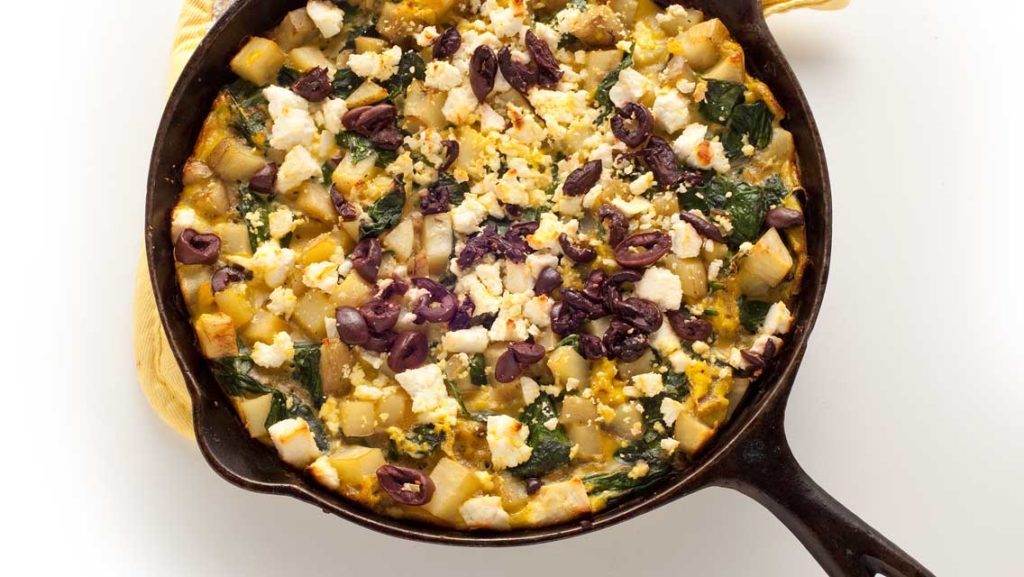
Serves | six to eight
Ingredients
- 2 tbs. extra-virgin olive oil
- 1/2 yellow onion, finely chopped
- 3 medium Yukon Gold potatoes, cut into ½-inch cubes (about 3 cups)
- 5 ounces fresh spinach leaves, stems removed
- 1/2 tsp. salt
- 1/2 tsp. freshly ground black pepper
- 8 eggs, beaten
- 8 pitted Kalamata olives, sliced
- 1/2 cup crumbled ricotta salata cheese
Directions
- Preheat oven to 350 degrees F.
- Heat olive oil in a heavy 8-inch skillet and sauté the onion until just beginning to soften. Add the potatoes and continue to cook until al dente (firm to the bite). Add the spinach to the skillet and stir briefly to wilt. Mix the salt and pepper with the beaten eggs and pour into the skillet, stirring gently to allow the egg to reach the bottom of the skillet.
- With a rubber spatula, gently lift the egg as it cooks to allow more of the raw egg to reach the bottom of the skillet. When the egg is mostly set on the bottom and sides of the frittata, remove from heat and top with the sliced olives and cheese.
- Place the pan in the oven and bake for 15 to 20 minutes, or until the frittata is cooked through.
- Serve warm or at room temperature.
Curried Garbanzo Beans With Spinach
Serve this tasty curry with brown rice and top with cilantro-mint chutney. (For the chutney recipe, see further down) If you love cilantro, you can add a handful of chopped fresh cilantro to the curry along with the spinach. If you don’t like cilantro, try parsley instead.
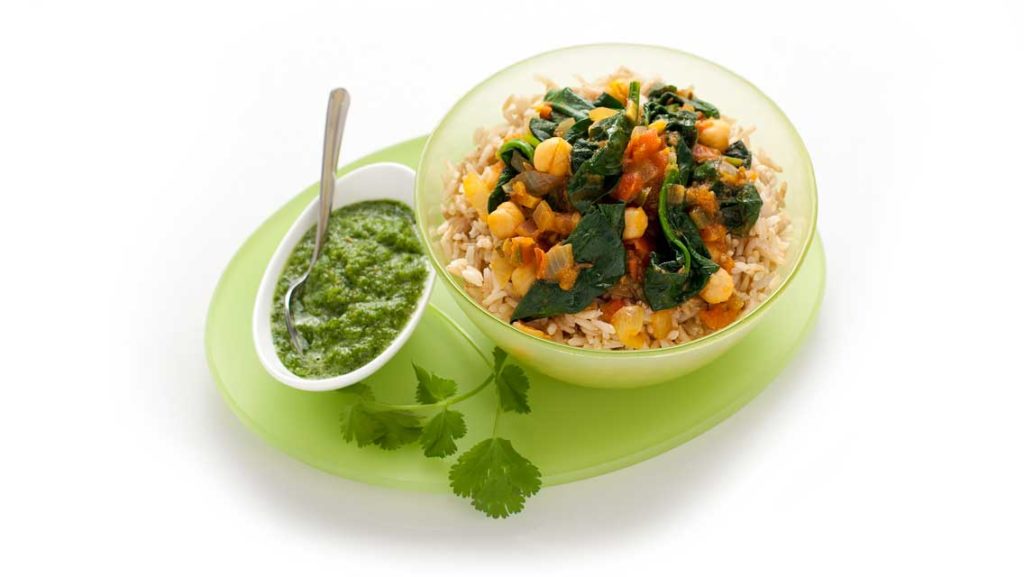
Serves | four
Ingredients
- 1 tbs. ghee or coconut oil
- 1 medium onion, minced (about 1 cup)
- 2 tbs. minced jalapeño pepper
- 2 tbs. minced gingerroot
- 1 tbs. whole cumin seeds
- 2 tsp. ground coriander
- 1/2 tsp. turmeric
- 1/2 tsp. salt
- 3 cups diced tomato
- 1/2 to 1 cup water
- 1 15-ounce can garbanzo beans, rinsed and drained
- 5 ounces fresh spinach
Directions
- Heat ghee in a large skillet or saucepan over medium-low heat. Add the onion, jalapeño, gingerroot and cumin seeds to the skillet and cook until all vegetables are softened. Add the coriander, turmeric and salt, and cook for another couple of minutes until fragrant.
- Turn the heat up to medium-high, add the diced tomatoes, and cook until the tomatoes are soft and saucy. (Add water as needed, depending on the moisture content of the tomatoes.)
- Add the garbanzo beans and cook to heat through. Add the spinach and stir to wilt.
Stuffed Chicken Breast With Spinach, Mushrooms and Parmesan Cheese
You can easily change up this hearty main dish. For a Greek flavor, sub in chopped Kalamata olives, feta cheese and chopped tomatoes for the mushrooms, garlic and Parmesan cheese. For Thai, toss the spinach with mushrooms, bean sprouts and a ginger-peanut sauce.

Serves | four
Ingredients
- 2 tbs. extra-virgin olive oil, divided
- 4 boneless skinless chicken breast halves
- 6 small cremini mushrooms, sliced thin
- 4 cups spinach
- 2 cloves garlic, minced
- ¼ cup grated Parmesan cheese
- Salt and fresh ground black pepper to taste
Directions
- Preheat oven to 375 degrees F.
- Drizzle 1 tablespoon of the olive oil in a 6-inch-by-8-inch baking dish.
- Make a crosswise slit in each chicken breast, about halfway through the chicken breast, to make a “pocket” for the stuffing.
- Sauté the mushrooms in the remaining olive oil until soft. Add the spinach and garlic and cook until the spinach is wilted. Stir in grated Parmesan cheese and season with salt and pepper to taste.
- Fill each chicken breast with the spinach mixture and arrange the stuffed chicken breasts in the baking dish.
- Bake for 25 to 30 minutes, or until chicken is completely cooked through.
- Serve the chicken with fresh salad greens.
Cilantro Mint Chutney
A simple, yet flavorful chutney filled with fresh and herby flavors that pairs perfectly with the Curried Garbanzo Beans With Spinach recipe from above. Can also be used as a dipping sauce with your favorite Indian food.
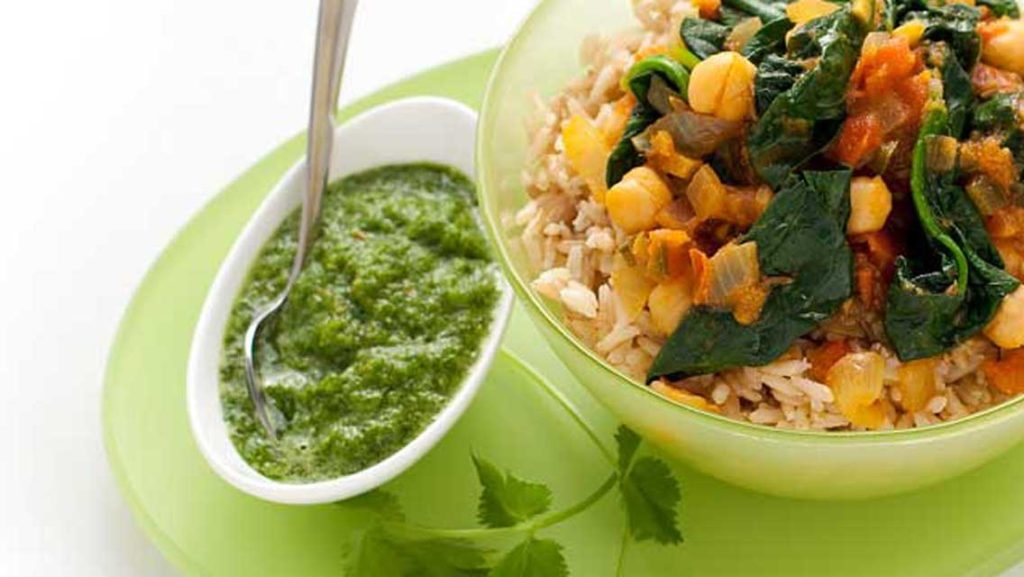
Makes | about 1 1/2 cups
Ingredients
- 1 small jalapeño, about 2 tbs., coarsely chopped
- 2 garlic cloves
- 1/2 yellow onion, about 1/2 cup, coarsely chopped
- 1-inch chunk fresh gingerroot, coarsely chopped
- 1 tomato, coarsely chopped
- 1 cup cilantro, coarsely chopped
- 1/4 cup mint leaves, coarsely chopped
Directions
- Salt to taste
- Blend all ingredients together in a blender until smooth. Store in the refrigerator until ready to serve.
Better Soil, Better Spinach
Bob Cannard pays attention to what plants need because he knows that healthy plants make healthy food. Best known as the produce supplier for Alice Waters’s Chez Panisse restaurant in Berkeley and as one of the pioneers of the organic farming movement in California, Cannard has watched big, industrial farms hijack the “organic” label. He’s now trying to return organic farming to its roots by promoting local food grown with respect for the land.
At Cannard Farms in Sonoma and at the Green String Institute, an educational nonprofit he founded with winemaker Fred Cline, he teaches future farmers the finer points of soil biology. “We want to grow soils, and to make soils progressively more vital, while we feed and grow our own bodies,” he says.
We talked with Cannard about how good soil makes better spinach and healthier people.
EL: What should we look for in great spinach?
BC: It should have strong, sturdy leaves with good symmetry and a high level of resistance to bruising, equalness in color between the younger leaves and older leaves, and a very mild, clean, clear, spinach-y taste and aroma. Conventional spinach is grown in soil that is pumped up with nitrogen-rich fertilizer; as a result, the spinach has a sharp edge and a nondigestible quality to it.
EL: Do you have a farming philosophy?
BC: I believe that plants have complete immune systems, and if they are growing in a nutritional, foundational environment that provides everything they require, they won’t have any deterioration. Here at the Green String Institute, we have an aversion to killing bugs because when plants are healthy, they have natural defenses against pests. In conventional farming, a plant doesn’t have true nutritional soundness, and so when it gets bugs, you go out and kill the bugs with pesticides and insecticides.
EL: What’s the advantage of buying locally grown spinach?
BC: With spinach, there is a loss of vitamins within hours after harvest. So, ideally, you want to buy from somebody who’s growing, harvesting and delivering the spinach more rapidly. Cut, bagged spinach that has a two- or three-week shelf life has fewer vitamins and nutrients.
EL: Why does soil quality matter so much?
BC: A lot of our physical ills are associated with nutrient deficiencies, especially deficiencies of minerals, which are critical to all kinds of biochemical processes. Many of our mineral deficiencies are the result of eating foods grown in depleted soils — a huge problem with conventional agriculture. I sincerely believe that if we were to learn how to grow nutrient-dense foods sustainably on a worldwide scale, we would vastly reduce our rates of disease and chronic illness.
All of these recipes were created by Betsy Nelson (a.k.a. “That Food Girl”), a Minneapolis-based food stylist and recipe developer.
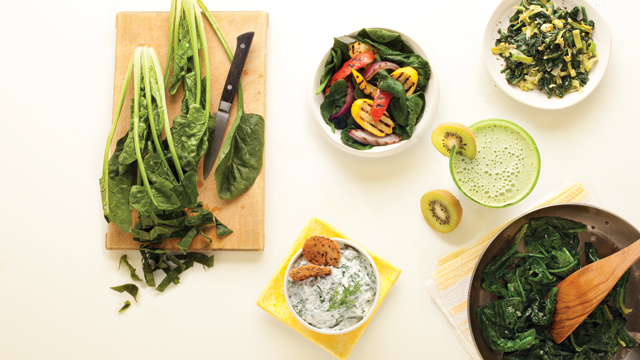

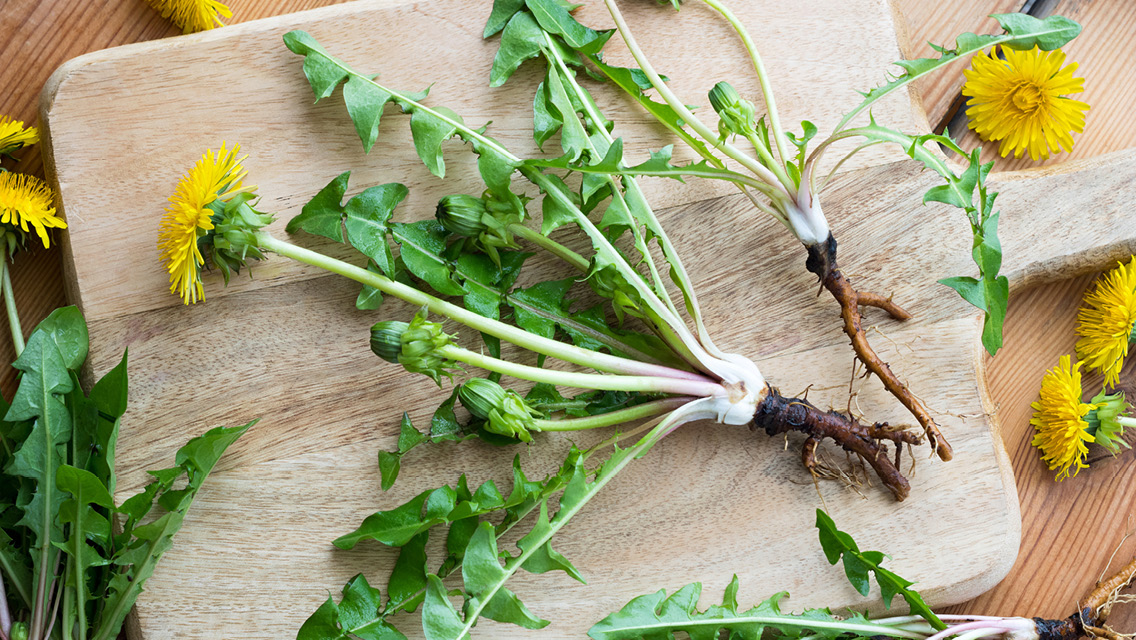

This Post Has 0 Comments